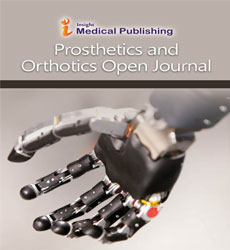Abstract
Averaged and Personalized Mathematical Modeling of Biomechanics of a System Limb-Orthosis
Introduction: Despite the growing use of orthoses in clinic, sports and everyday life, mechanical and mathematical modeling of "Leg-Orthosis" system, is as yet only at the beginning of its development. Previously a minimal basic biomechanical model of a shin-orthosis system has been proposed. This model was pretty coarse, so two more accurate models were developed: generalized typified model and personalized model.
Materials and methods: At averaged modeling of the limborthosis system the shin was modeled by elastic isotropic double truncated cone (muscles) with a rigid cylindrical core (tubular bone), the foot placed into a rigid shin-conformal cone (orthosis) and loaded with the body weight. Calculations were carried out using the software package that implemented the boundary element method with a quadratic approximation of the variables of the problem. For individual (personalized) modeling the shin multislice computed tomography (MSCT) in vivo was performed. Import of this tomogram into Mimics package allowed to get a 3D model of the shin, and after completing it with an orthosis – a 3D mesh model of the shin-orthosis system, which was then passed to the FEM package for computations. In both cases condition of full adhesion of bone and muscles was set, the body weight applied to the bone and transmitted to the muscles through the bonemuscle interface.
Results: Fields of stresses and displacements were defined numerically in both models. It has been found that under certain conditions slippage can occur on the shin-orthosis interface, that is necessary for the possibility of unloading control of the shin in an orthosis through changing lateral tightening. In the typified model one calculation took fraction of a second, in the personalized one – many hours with a typical modern powerful computer. However, personalized approach allowed to take into account the real three-dimensional geometry of the shin and the tibia.
Conclusion: Technique, developed on the basis of a typed conical model using BEM, enabled rapid parametric study of the leg-orthosis model stress-strain state. Personalized approach allowed to take into account real geometry. Moreover, with the personalized model the relation between CT images radiopacity and bone density according to Hounsfield scale, as well as theoretical and empirical relation between bone density and its Young's modulus allow to specify in the model inhomogeneous distribution of the Young's modulus.
Author(s): Il’ya N Dashevskiy, Mikhail N Perel'muter, Pavel S Shushpannikov
Abstract | Full-Text | PDF
Share This Article
Abstracted/Indexed in
- Secret Search Engine Labs
Open Access Journals
- Aquaculture & Veterinary Science
- Chemistry & Chemical Sciences
- Clinical Sciences
- Engineering
- General Science
- Genetics & Molecular Biology
- Health Care & Nursing
- Immunology & Microbiology
- Materials Science
- Mathematics & Physics
- Medical Sciences
- Neurology & Psychiatry
- Oncology & Cancer Science
- Pharmaceutical Sciences
